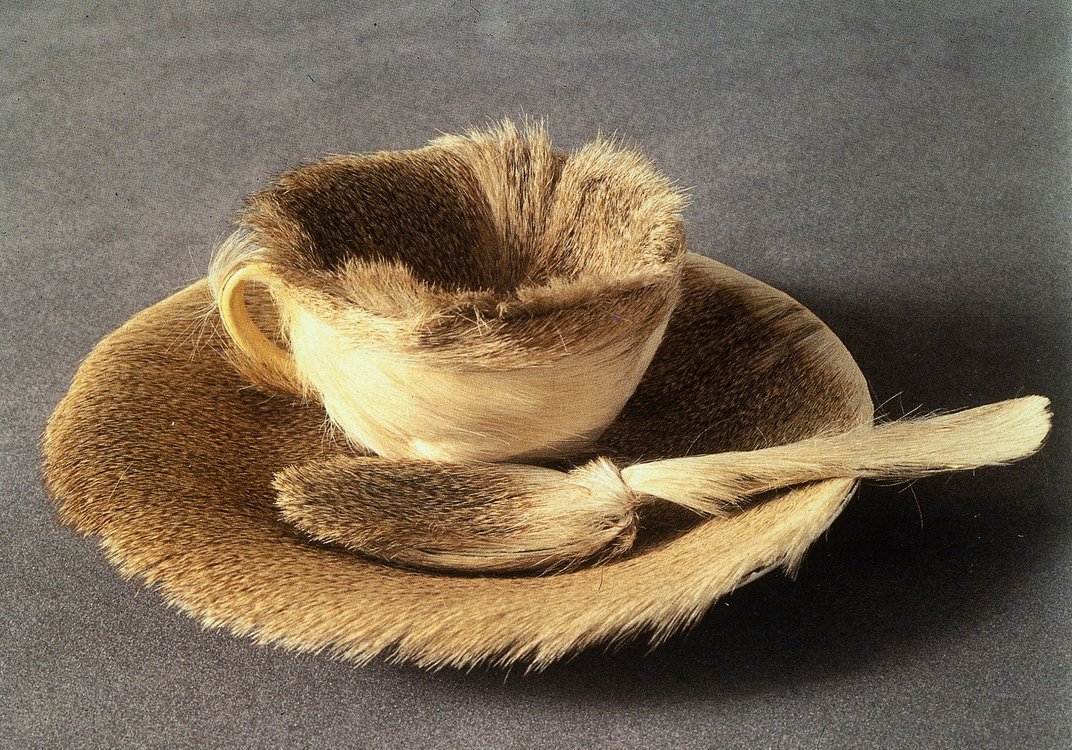The teacup and the cosmos
Floating World X: Pedestal.
I recently posted a new gallery called Floating World. This group of paper collages (named after the Japanese ukiyo-e tradition, which means “pictures of the floating world”) were all created during the pandemic. Beloved domestic items have somehow become unmoored, from teacups and dinner plates to jewels and toy robots. The curtains are open and the doors are unhinged. As in the other Cosmos Nocturnes, the churning heavens are ever-present in the background.
As I finished up these collages, I showed them to a couple friends after dinner. After the whole set of twelve had been assembled on the table—all these toys and teacups adrift in the rowdy cosmos—one man was noticeably quiet. “What comes to mind?” I asked him.
“Loss,” he said.
“Where do you see it?”
“Everywhere.”
Another friend told me she felt queasy. A third said, “Surrealism. That’s what this is.”
“Object” (1936), by Meret Oppenheim. Museum of Modern Art, NYC.
I’ve been drawn to surrealism for years—especially the work of Max Ernst, Magritte, Joseph Cornell, and Meret Oppenheim. Surrealism was an experimental, wide-ranging art movement, born of the PTSD-rattled decades between WWI and WWII. A common theme weaving through all these works is the realm of dreams and the unconscious that upends the familiar comfort of everyday things.
Surrealism never really went away, but it’s having a moment again. This is evident in shows like Surrealism Beyond Borders, the blockbuster exhibition at The Metropolitan Museum of Art that closed in January. If you find yourself in Houston, Texas in the next few months, you can see Meret Oppenheim: My Exhibition, a brilliant, long overdue show that just opened at The Menil Collection. Oppenheim is an underappreciated surrealist master. Her iconic fur-covered teacup, saucer, and spoon sculpture “Object” embodies the disruptive poetry of the era.
Our era, too, is full of old orders disrupted by unexpected winds. No one is spared from a profound loss of equilibrium. A global pandemic wreaks havoc on our foundations and erodes our sense of stability; even a multi-year retreat into our homes has not sheltered us from the winds of change blowing through the walls.
Floating World V: Tassel.
My ongoing interest in collage is also characteristic of surrealism. Collage was itself an invention of the early 20th century (think Braque, Picasso, and Juan Gris). This medium is well-suited for unsettled times because it thrives on surprise findings and the juxtaposition of unrelated things. Collage was the medium of choice for artists who embraced a world beyond the limitations of logic and order, transporting familiar objects into unexpected dimensions of experience.
This is exactly what happens in the Floating World. Who unplugged the gravity? We see a comfortable chair, a beloved portrait, someone’s toy robot, the rumpled covers of an unmade bed, and granny’s favorite cherry pattern that graced her best china plates. No longer bound to earth, this collection of everyday ephemera handed down through the generations is now drifting in the currents of a cosmic stream, accompanied by shining stars and spinning galaxies.
The secret to this image-making approach is that seemingly unrelated things do not, in fact, have to be reconciled. Maybe they can’t ever be. Maybe that’s okay. In the end, after all, it's not really about our things. They serve as a kind of “touch point” or vessel for our sense of what matters. We care about our belongings because of the memories they hold—the people we love, the times we remember, and the things that make us smile. Maybe the loss we feel when our lives are disrupted is also the place where a heartbreaking kind of beauty comes in, the vulnerable tenderness we feel because we know things don’t last forever. This is the beauty of impermanence and the impermanence of beauty.
Floating World I: Raft.
Recognizing this beauty helps to explain the enduring charm of the small, palm-sized netsuke that have found their way into the collages (“Raft,” “Pearl,” “Rocket,” “Basket”). I wrote about my encounter with these delightful creations in a previous post. In the Floating World, a moment in time has been frozen: the surprised bunny checks out a glistening pearl as an appetizer dish sails in from behind; an amused mama tiger grooms her precious cub who is enchanted with the hunting dog pendant floating by; the sleepy-eyed goat curled up against a red leather footstool watches a toy rocket blasting off into space.
What does it mean to belong to something that is so dear, but doesn’t last?
Most likely, we will never know the answer. Still, here we are, together in a mad, unruly, beautiful world, with galaxies yawning around us. We may not be equipped to make an easy peace between the teacup and the cosmos. But we can follow in the path of surrealism and say yes to all of it.
“It appears to me impossible that I should cease to exist, or that this active, restless spirit, equally alive to joy and sorrow, should only be organized dust.”



